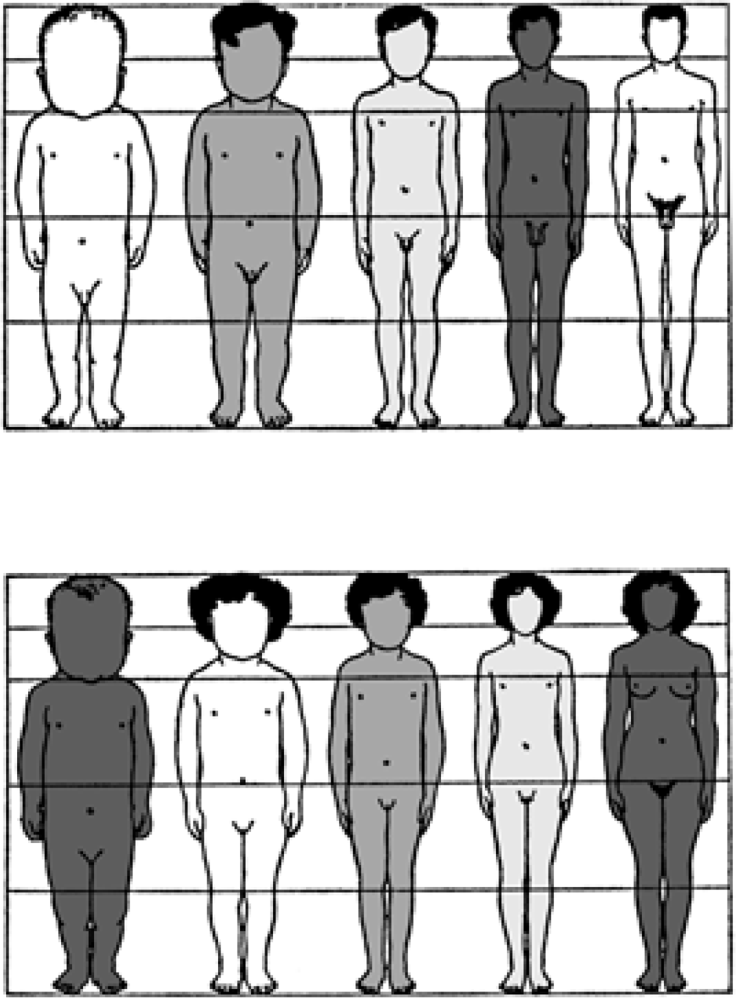http://www.google.com.au/url?sa=t&rct=j&q=&esrc=s&source=web&cd=5&cad=rja&uact=8&ved=0CDcQFjAE&url=http%3A%2F%2Fwww.mdpi.com%2F1660-4601%2F7%2F3%2F1047%2Fpdf&ei=5TxSVI2LJuXUmgW4moLAAg&usg=AFQjCNESdZntA0xM4z9TWtPFt0w3L5xC4g&bvm=bv.78597519,d.dGY
Quote
on general principles that children continuously underfed would grow
into underdeveloped adults. . .with normal or nearly normal size head, moderately retarded trunk and
relatively short legs.’ Reviewing the literature available at the time (pre-1950), Leitch found that
improved nutrition during infancy and childhood did result in a greater increase in LL than in total
height or weight.
Quote
Frisancho et al. [107] emphasize the
environmental effects in a study that finds that leg length of Mexican-Americans aged 2–17 years old
is significantly associated with socioeconomic status of their families. In that study, individuals from
better-off families have significantly longer legs, but equal trunk length, when compared with boys and
girls from poorer families.
Quote
Dangour [115] reports similar findings for two tribes of Amerindian
children living in Guyana. The tribes are both of low socioeconomic status, but differ markedly in the
quality of their living conditions. Children in the tribe with better living conditions are taller than their
age-mates in the other tribe. The difference in stature is due almost entirely to differences in leg length,
as there are no significant differences in sitting height between the tribes.
Quote
The values indicate that about 60% of the increase in stature is due
to longer legs. Consequently, the taller Maya-Americans have a significantly lower average sitting height
ratio than do the Maya in Guatemala.
Quote
Overall, mean stature is greater for the centre group than the slum group, but relative leg
length as measured by the sitting height ratio does not differ.(NHANES II),
all slum girls,all slum boys, show relatively shorter legs.
and finally. drum role.......a medical study link showing crotch at half the height for an adult human of 25 years of age [/b]as an average.
Quote
Figure 6. Changes in body proportion during human growth after birth. Ages for each
profile are, from left to right, newborn, 2 years, 6 years, 12 years, 25 years. The hair style
and shading of the cartoon silhouettes are for artistic purposes and is not meant to imply
any ethnic, eco-geographical, or “racial” phenotypic characteristics of the human species
[provided courtesy of Dr. J. V. Basmajian].
the bottom line is simple. if your short your going to have short legs, and it is probably from under nutrition. almost all of the population suffers from malnutrition. the body preserves sitting height first when you suffer from malnutrition. your sitting height remains unaffected and your leg length becomes crap. that's how it works!
as you become taller from LL you become closer to the golden ratio. this is because when you stunted your growth from under nutrition your body preserved your sitting height with the nutrients it had and took your height from your legs( this is genetic programing). it did not do this to people who were not malnutritioned and became taller compared to average.
every single person suffers from malnutrition to different degrees.
this is why people who are short can get a lot of LL compared to people who are tall(and still stay in proportion), it is because your body decided to steal your height from your legs specifically! that's how genetics work! that's what the medical studies state.
the problem with this world is that everyone has an opinion and no one reads.

 Author
Topic: Do tall guys usually have longer legs in relation to torso? (Read 19714 times)
Author
Topic: Do tall guys usually have longer legs in relation to torso? (Read 19714 times)
